Abstract
Two issues in the evolution of the intron/exon structure of genes are the role of exon shuffling and the origin of introns. Using a large data base of eukaryotic intron-containing genes, we have found that there are correlations between intron phases leading to an excess of symmetric exons and symmetric exon sets. We interpret these excesses as manifestations of exon shuffling and make a conservative estimate that at least 19% of the exons in the data base were involved in exon shuffling, suggesting an important role for exon shuffling in evolution. Furthermore, these excesses of symmetric exons appear also in those regions of eukaryotic genes that are homologous to prokaryotic genes: the ancient conserved regions. This last fact cannot be explained in terms of the insertional theory of introns but rather supports the concept that some of the introns were ancient, the exon theory of genes.
Full text
PDF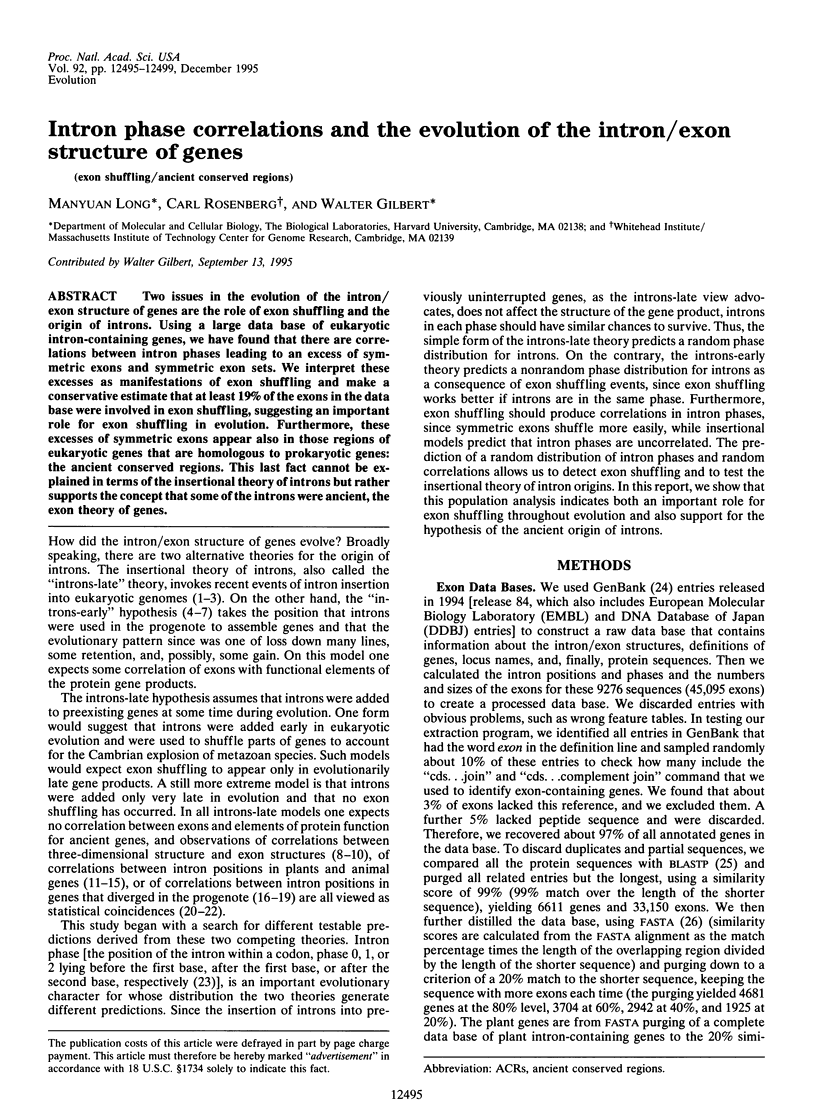
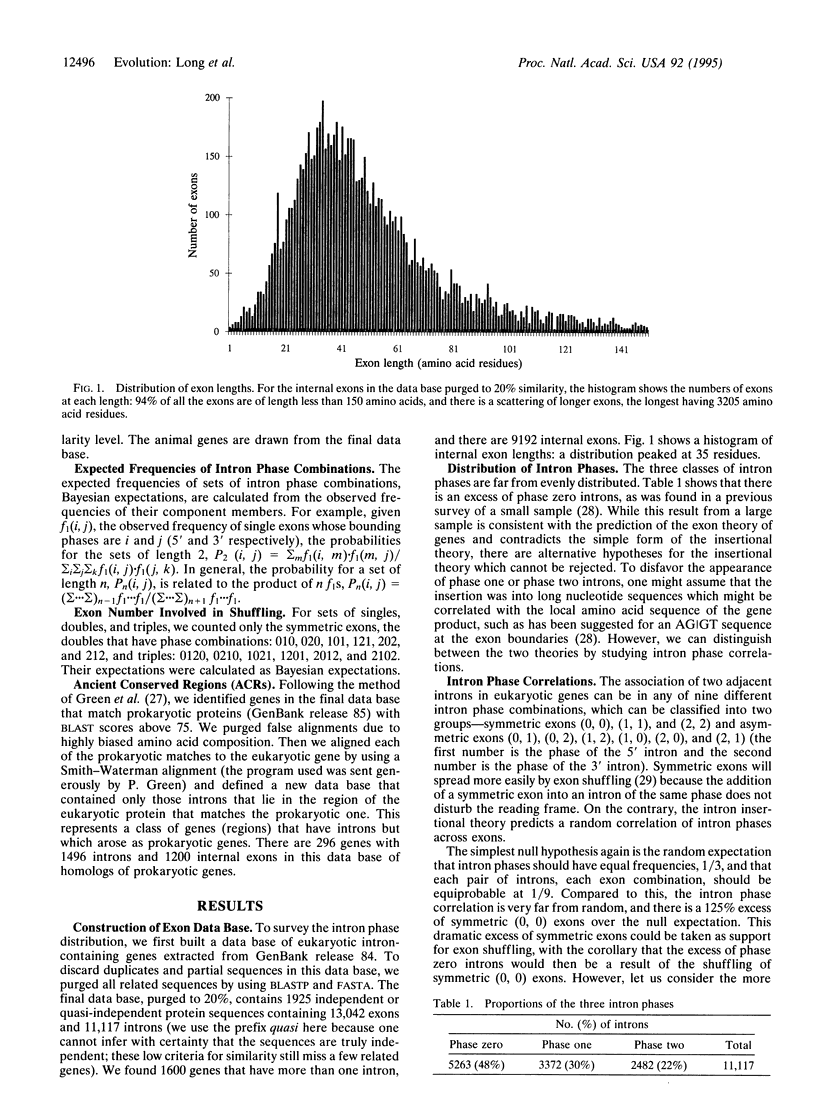
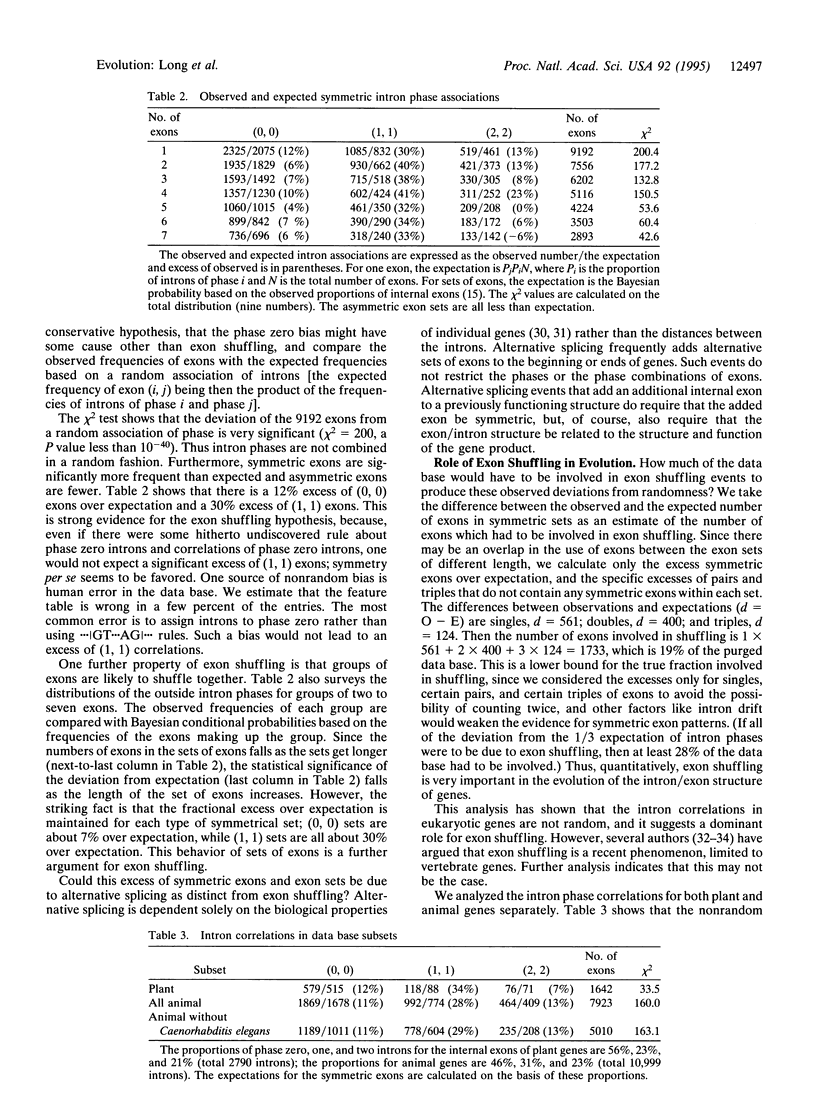
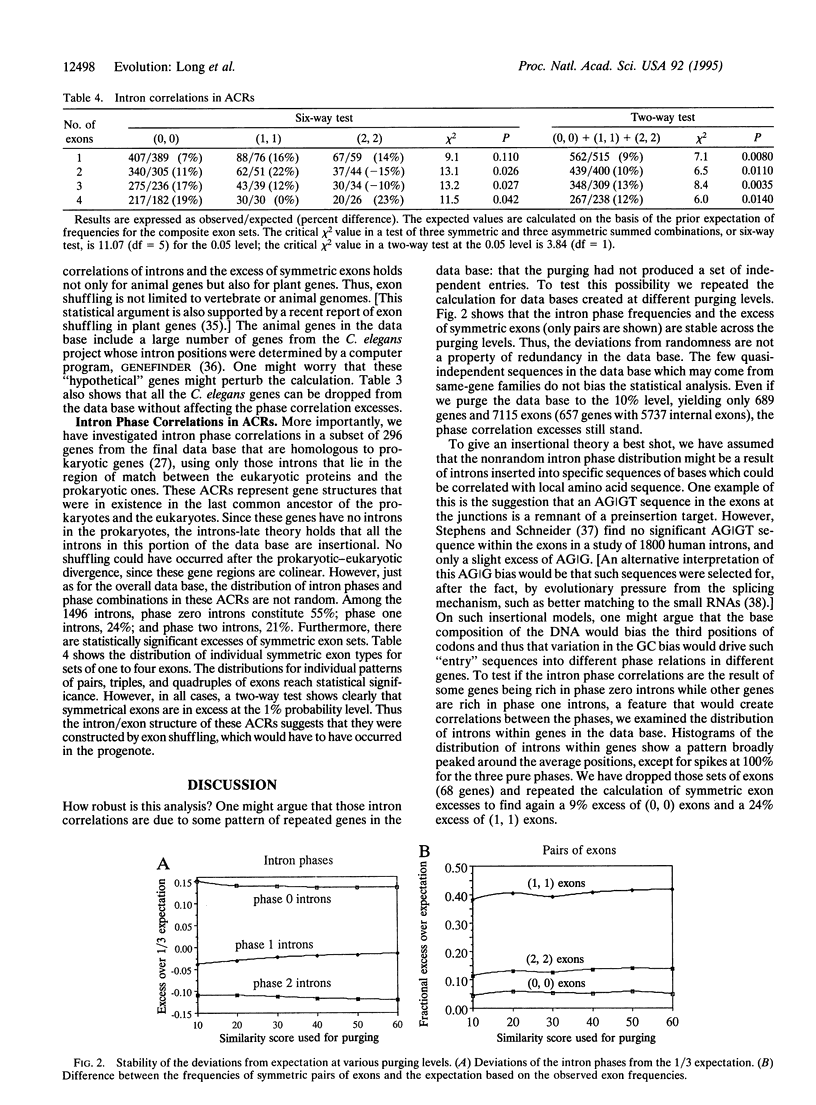
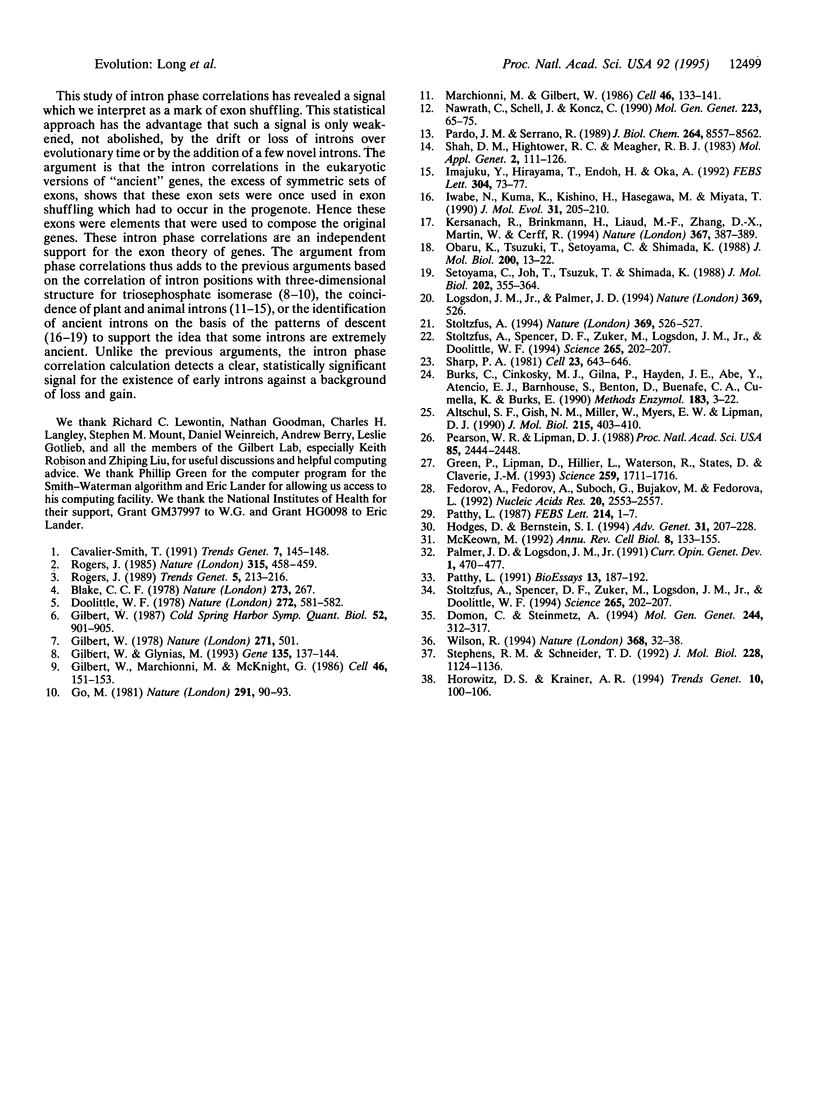
Selected References
These references are in PubMed. This may not be the complete list of references from this article.
- Altschul S. F., Gish W., Miller W., Myers E. W., Lipman D. J. Basic local alignment search tool. J Mol Biol. 1990 Oct 5;215(3):403–410. doi: 10.1016/S0022-2836(05)80360-2. [DOI] [PubMed] [Google Scholar]
- Burks C., Cinkosky M. J., Gilna P., Hayden J. E., Abe Y., Atencio E. J., Barnhouse S., Benton D., Buenafe C. A., Cumella K. E. GenBank: current status and future directions. Methods Enzymol. 1990;183:3–22. doi: 10.1016/0076-6879(90)83003-r. [DOI] [PubMed] [Google Scholar]
- Cavalier-Smith T. Intron phylogeny: a new hypothesis. Trends Genet. 1991 May;7(5):145–148. [PubMed] [Google Scholar]
- Domon C., Steinmetz A. Exon shuffling in anther-specific genes from sunflower. Mol Gen Genet. 1994 Aug 2;244(3):312–317. doi: 10.1007/BF00285459. [DOI] [PubMed] [Google Scholar]
- Fedorov A., Suboch G., Bujakov M., Fedorova L. Analysis of nonuniformity in intron phase distribution. Nucleic Acids Res. 1992 May 25;20(10):2553–2557. doi: 10.1093/nar/20.10.2553. [DOI] [PMC free article] [PubMed] [Google Scholar]
- Gilbert W., Glynias M. On the ancient nature of introns. Gene. 1993 Dec 15;135(1-2):137–144. doi: 10.1016/0378-1119(93)90058-b. [DOI] [PubMed] [Google Scholar]
- Gilbert W., Marchionni M., McKnight G. On the antiquity of introns. Cell. 1986 Jul 18;46(2):151–153. doi: 10.1016/0092-8674(86)90730-0. [DOI] [PubMed] [Google Scholar]
- Gilbert W. The exon theory of genes. Cold Spring Harb Symp Quant Biol. 1987;52:901–905. doi: 10.1101/sqb.1987.052.01.098. [DOI] [PubMed] [Google Scholar]
- Gilbert W. Why genes in pieces? Nature. 1978 Feb 9;271(5645):501–501. doi: 10.1038/271501a0. [DOI] [PubMed] [Google Scholar]
- Go M. Correlation of DNA exonic regions with protein structural units in haemoglobin. Nature. 1981 May 7;291(5810):90–92. doi: 10.1038/291090a0. [DOI] [PubMed] [Google Scholar]
- Green P., Lipman D., Hillier L., Waterston R., States D., Claverie J. M. Ancient conserved regions in new gene sequences and the protein databases. Science. 1993 Mar 19;259(5102):1711–1716. doi: 10.1126/science.8456298. [DOI] [PubMed] [Google Scholar]
- Hodges D., Bernstein S. I. Genetic and biochemical analysis of alternative RNA splicing. Adv Genet. 1994;31:207–281. doi: 10.1016/s0065-2660(08)60399-5. [DOI] [PubMed] [Google Scholar]
- Horowitz D. S., Krainer A. R. Mechanisms for selecting 5' splice sites in mammalian pre-mRNA splicing. Trends Genet. 1994 Mar;10(3):100–106. doi: 10.1016/0168-9525(94)90233-x. [DOI] [PubMed] [Google Scholar]
- Imajuku Y., Hirayama T., Endoh H., Oka A. Exon-intron organization of the Arabidopsis thaliana protein kinase genes CDC2a and CDC2b. FEBS Lett. 1992 Jun 8;304(1):73–77. doi: 10.1016/0014-5793(92)80592-5. [DOI] [PubMed] [Google Scholar]
- Iwabe N., Kuma K., Kishino H., Hasegawa M., Miyata T. Compartmentalized isozyme genes and the origin of introns. J Mol Evol. 1990 Sep;31(3):205–210. doi: 10.1007/BF02109497. [DOI] [PubMed] [Google Scholar]
- Kersanach R., Brinkmann H., Liaud M. F., Zhang D. X., Martin W., Cerff R. Five identical intron positions in ancient duplicated genes of eubacterial origin. Nature. 1994 Jan 27;367(6461):387–389. doi: 10.1038/367387a0. [DOI] [PubMed] [Google Scholar]
- Logsdon J. M., Jr, Palmer J. D. Origin of introns--early or late? Nature. 1994 Jun 16;369(6481):526–528. doi: 10.1038/369526a0. [DOI] [PubMed] [Google Scholar]
- Marchionni M., Gilbert W. The triosephosphate isomerase gene from maize: introns antedate the plant-animal divergence. Cell. 1986 Jul 4;46(1):133–141. doi: 10.1016/0092-8674(86)90867-6. [DOI] [PubMed] [Google Scholar]
- McKeown M. Alternative mRNA splicing. Annu Rev Cell Biol. 1992;8:133–155. doi: 10.1146/annurev.cb.08.110192.001025. [DOI] [PubMed] [Google Scholar]
- Nawrath C., Schell J., Koncz C. Homologous domains of the largest subunit of eucaryotic RNA polymerase II are conserved in plants. Mol Gen Genet. 1990 Aug;223(1):65–75. doi: 10.1007/BF00315798. [DOI] [PubMed] [Google Scholar]
- Obaru K., Tsuzuki T., Setoyama C., Shimada K. Structural organization of the mouse aspartate aminotransferase isoenzyme genes. Introns antedate the divergence of cytosolic and mitochondrial isoenzyme genes. J Mol Biol. 1988 Mar 5;200(1):13–22. doi: 10.1016/0022-2836(88)90329-4. [DOI] [PubMed] [Google Scholar]
- Palmer J. D., Logsdon J. M., Jr The recent origins of introns. Curr Opin Genet Dev. 1991 Dec;1(4):470–477. doi: 10.1016/s0959-437x(05)80194-7. [DOI] [PubMed] [Google Scholar]
- Pardo J. M., Serrano R. Structure of a plasma membrane H+-ATPase gene from the plant Arabidopsis thaliana. J Biol Chem. 1989 May 25;264(15):8557–8562. [PubMed] [Google Scholar]
- Patthy L. Exons--original building blocks of proteins? Bioessays. 1991 Apr;13(4):187–192. doi: 10.1002/bies.950130408. [DOI] [PubMed] [Google Scholar]
- Patthy L. Intron-dependent evolution: preferred types of exons and introns. FEBS Lett. 1987 Apr 6;214(1):1–7. doi: 10.1016/0014-5793(87)80002-9. [DOI] [PubMed] [Google Scholar]
- Pearson W. R., Lipman D. J. Improved tools for biological sequence comparison. Proc Natl Acad Sci U S A. 1988 Apr;85(8):2444–2448. doi: 10.1073/pnas.85.8.2444. [DOI] [PMC free article] [PubMed] [Google Scholar]
- Rogers J. H. How were introns inserted into nuclear genes? Trends Genet. 1989 Jul;5(7):213–216. doi: 10.1016/0168-9525(89)90084-x. [DOI] [PubMed] [Google Scholar]
- Rogers J. Exon shuffling and intron insertion in serine protease genes. Nature. 1985 Jun 6;315(6019):458–459. doi: 10.1038/315458a0. [DOI] [PubMed] [Google Scholar]
- Setoyama C., Joh T., Tsuzuki T., Shimada K. Structural organization of the mouse cytosolic malate dehydrogenase gene: comparison with that of the mouse mitochondrial malate dehydrogenase gene. J Mol Biol. 1988 Aug 5;202(3):355–364. doi: 10.1016/0022-2836(88)90270-7. [DOI] [PubMed] [Google Scholar]
- Shah D. M., Hightower R. C., Meagher R. B. Genes encoding actin in higher plants: intron positions are highly conserved but the coding sequences are not. J Mol Appl Genet. 1983;2(1):111–126. [PubMed] [Google Scholar]
- Sharp P. A. Speculations on RNA splicing. Cell. 1981 Mar;23(3):643–646. doi: 10.1016/0092-8674(81)90425-6. [DOI] [PubMed] [Google Scholar]
- Stephens R. M., Schneider T. D. Features of spliceosome evolution and function inferred from an analysis of the information at human splice sites. J Mol Biol. 1992 Dec 20;228(4):1124–1136. doi: 10.1016/0022-2836(92)90320-j. [DOI] [PubMed] [Google Scholar]
- Stoltzfus A. Origin of introns--early or late. Nature. 1994 Jun 16;369(6481):526–528. doi: 10.1038/369526b0. [DOI] [PubMed] [Google Scholar]
- Stoltzfus A., Spencer D. F., Zuker M., Logsdon J. M., Jr, Doolittle W. F. Testing the exon theory of genes: the evidence from protein structure. Science. 1994 Jul 8;265(5169):202–207. doi: 10.1126/science.8023140. [DOI] [PubMed] [Google Scholar]
- Stoltzfus A., Spencer D. F., Zuker M., Logsdon J. M., Jr, Doolittle W. F. Testing the exon theory of genes: the evidence from protein structure. Science. 1994 Jul 8;265(5169):202–207. doi: 10.1126/science.8023140. [DOI] [PubMed] [Google Scholar]
- Wilson R., Ainscough R., Anderson K., Baynes C., Berks M., Bonfield J., Burton J., Connell M., Copsey T., Cooper J. 2.2 Mb of contiguous nucleotide sequence from chromosome III of C. elegans. Nature. 1994 Mar 3;368(6466):32–38. doi: 10.1038/368032a0. [DOI] [PubMed] [Google Scholar]


